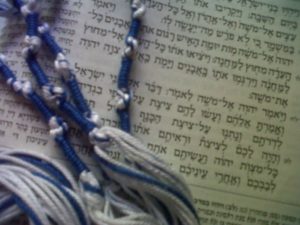“Adonai said to Moshe, ‘Speak to the people of Isra’el, instructing them to make, through all their generations, tzitziyot on the corners of their garments, and to put with the tzitzit on each corner a blue thread.'”-Numbers 15:37-38
Yesterday we discussed the man who was stoned for gathering firewood on the Shabbat.
We learned that the man was subjected to two penalties: A civil penalty and KARET (being divinely “cut-off”).
The first civil penalty was the end of the man’s physical life on this earth by stoning.
The second penalty was the “cutting off” of the man’s soul from God after his earthly death.
Again, in Hebrew this is called KARET.
These two penalties together demonstrate that we human beings have both physical and spiritual sides to us.
Human governments deal with the physical aspect of punishment for breaking civil laws.
And God deals with the spiritual aspect of punishment.
This makes sense.
The act of KARET is so serious and given that it is a permanent action, there is no way this particular type of judgement should be left in the hands of men.
You may be kicked out of your church and told that you have now been separated from God, but the truth is only God Himself holds the power to dissolve the relationship between you and Him.
No human institution, whether it be seat of Moses or the Vatican holds that right.
Next, we’re going to be discussing what is called in Hebrew TZITZIT.
These are those specially knotted ritual fringes or tassels you see attached to the hems of the garments of observant Jews.
It actually makes sense that the command to wear TZITZIT follows immediately after the stoning of the man who was gathering firewood.
If he had perhaps had a physical and visible reminder to be diligent and vigilant in keeping God’s commands, he may not have transgressed to the point of deserving the death penalty.
Literally speaking, TZITZIT just means a “lock of hair” and true to this definition it ancient times, that’s what TZITZITs were.
They were just elaborately spun locks of hair that eventually evolved into the tassels we have today.
As with many other things we find in the Torah, the TZITZIT wasn’t some new thing that just came onto the scene per God’s command.
The wearing of tassels on the fringe of one garments was some quite common throughout Asia Minor in ancient times.
What God did was take an already existing thing in ancient Middle Eastern culture and put His own unique spin on it.
And what was that unique spin?
Well, we’re told here in Numbers 15:39.
“It is to be a tzitzit for you to look at and thereby remember all of Adonai’s mitzvot and obey them, so that you won’t go around wherever your own heart and eyes lead you to prostitute yourselves”
Outside of the Biblical instructions here in Numbers 15, there is very little else said about the subject of TZITTZIT.
We have to look to other ancient sources and traditions outside of the Bible to get a deeper understanding of what the TZITTZIT were all about.
We learn a couple of interesting things by turning to these other sources.
The first thing we learn is that the hem of one’s garment was considered to be an extension of one’s personality and authority.
In other words, during Bible times, people wore hems as status symbols.
And we do the same thing today whenever we put on necklaces of crosses or the Star of David for example.
If you think about it, in a very real and visible way, the jewelry and other fashion items we wear are nothing less than visible extensions of not only our personalities but are in a sense messages to the outside world about who we are and what we believe in.
The second thing you need to understand is that in ancient times, the hem of one’s garment also carried legal authority.
More than just status symbols, they also served as a powerful form of legal identification just like a passport one shows to a customs officer before entering a foreign country.
In ancient times, royalty would have very intricate hems woven using the color purple to represent their authority.
Why purple?
Because in the Middle East, purple was universally recognized as a royal color.
Here’s another interesting thing I read about concerning how the hem of one’s garment was used.
When a servant of the royal palace was to present an official document to the king, the document was to be presented with a lock of air from the man’s head together with a cutoff piece from the hem of his garment.
This was the equivalent of a signature on a contract or a notarized seal.
Probably the biggest difference between how the gentile nations used TZITZIT compared with Israel in ancient times is that for the gentile nations, the use of TZITZIT was mainly connected to royalty and legal authority.
However, the Biblical command here in Numbers is directed to the common folk of Israel and their purpose is to remind Israel to keep the Lord’s commands.




Rich,
To add to your discussion, as far as Tzit-Tzit being a symbol of authority and prestige, we can confirm that with two examples from the New Covenant:
1. The woman with the hemorrhage touched the hem of Yeshua’s garment, in other words, His Tzit-Tzit, which represented His authority (in this case, to heal diseases); and
2. Yeshua’s admonition in Matthew 23:5 against the Pharisees who try to “lord it over” others and act more righteous than others…”Everything they do is done for people to see: They make their phylacteries wide and the tassels on their garments long;”
Great NT references Steven!